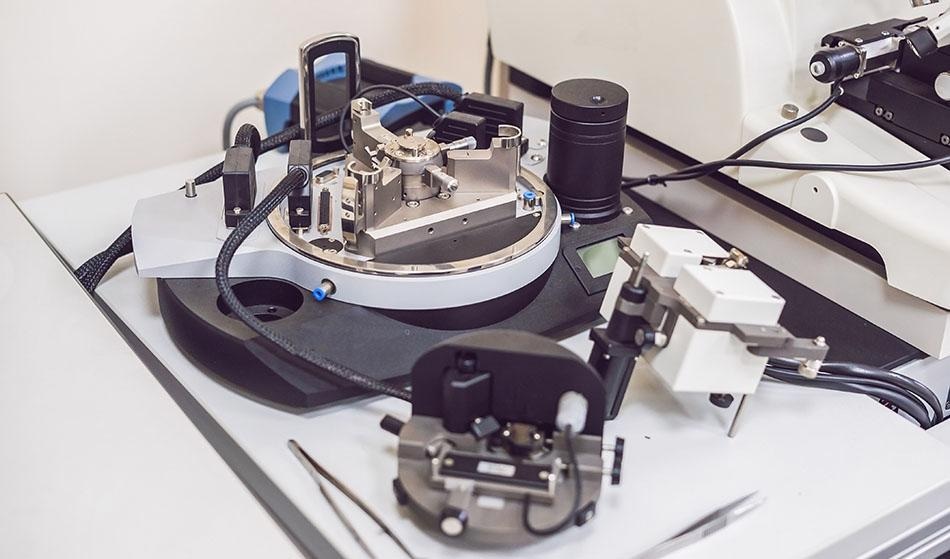
Elizaveta Galitckaia / Shutterstock
The atomic force microscope, developed by IBM researchers in the 1980s, is among the primary tools used by researchers to study, image and manipulate matter at the nanoscale. The technology has enabled entire new fields of study to be established, notably nano cell biology, after the 1997 discovery of the porosome. It is also currently being used by researchers in environmental sciences and clean technology and will help humans to develop the solutions that are needed to mitigate damage to the environment.
Atomic Force Microscopy
Atomic force microscopy (AFM), also known as scanning force microscopy (SFM), enables researchers to magnify images to a scale of fractions of a nanometer. Using a silicon or silicon nitride cantilever with a very sharp tip, whose radius of curvature is on the order of nanometers, atomic force microscopes can detect various physical forces between the device and the sample surface.
The cantilever is attached to a detector which measures the displacement of the cantilever as it is scraped over the specimen (in contact mode) and converts it into an electric signal. In non-contact modes, the various physical forces that the microscope is set up to detect produce the displacement. The electric signal detected can then be processed into a high-resolution image for study.
AFM is used to better understand solid-state physics, to research semiconductor materials and manufacturing processes, to support molecular engineering, to research molecular and cell biology, to develop pharmaceuticals and diagnostic methods, and increasingly, to support environmental sciences.
AFM in Environmental Science
AFM is used in numerous ways in environmental sciences and has helped researchers to both develop new clean technologies and better understand the potential environmental impact of new nanotechnologies.
Clean Technology
Clean technology is defined as:
“[A] set of technologies that either reduces or optimizes the use of natural resources, whilst at the same time reducing the negative effect that technology has on the planet and its ecosystems.” (Pirolini, 2015)
AFM is supporting these technologies by, for example, investigating how lithium-ion batteries degrade over time and developing materials for use in solar power generation (Moore, 2019).
AFM is also used by quantum computing researchers to support the creation of quantum spin states, giving the qubits that could potentially drive forward exponentially faster computers in the near future (Willke et al., 2018). If quantum computing can achieve its potential, the implications for a new generation of clean technology could drastically improve our chances of controlling and mitigating harmful environmental changes (Pilkington, 2019).
Understanding the Environmental Impact of New Nanotechnologies
AFM has been essential to the development of nanosciences, enabling the creation of many new nanotechnologies. However, concerns have been raised about the environmental impact of such technologies (Mody, 2011).
These concerns can be addressed with AFM. For instance, researchers at Arizona State University recently used AFM and other methods to find that nanosilver particles used in garment manufacture (specifically, socks) were released through washing and causing pollution in waterways, in turn polluting the entire water cycle. This research led to a court ban on the widely used flame retardant, citing environmental concerns (Lubick and Betts, 2008).
Using AFM to Control the Environment
As the examples above illustrate, AFM’s unique ability to image matter at the nanoscale has led to drastic leaps forward in various sciences which can be utilized to control the environment. With the declarations of climate crisis being made by governments around the world, this technology will continue to be used to develop new, clean technologies to minimize harm to the environment, and must continue to be used to monitor the environmental impact of other new – especially nanotechnologies.
Perhaps the greatest source of optimism in this regard is in the possibility of quantum computing, which through its vastly higher processing power could be utilized in the fight against climate change to take over entire systems, and monitor and control the environment to ensure no more damage is done.
Sources
- Lubick, N. and Betts, K. (2008). Silver socks have cloudy lining | Court bans widely used flame retardant. Environmental Science & Technology, 42(11), pp.3910–3910.
- Moore, S. (2019). The Benefits of AFM in Clean Technology. [online] AZoCleantech.com. Available at: https://www.azocleantech.com/article.aspx?ArticleID=976.
- Mody, C. (2011). Probe Microscopy and the Path to Nanotechnology. In Instrumental Community: Probe Microscopy and the Path to Nanotechnology (pp. 163-200). MIT Press. Retrieved from http://www.jstor.org/stable/j.ctt5hhjf0.9.
- Pilkington, B. (2019). Can Quantum Computing Aid Clean Technology? [online] AZoCleantech.com. Available at: https://www.azocleantech.com/article.aspx?ArticleID=935.
- Pirolini, A. (2015). What is Clean Technology? [online] AZoCleantech.com. Available at: https://www.azocleantech.com/article.aspx?ArticleID=532.
- Willke, P., Paul, W., Natterer, F.D., Yang, K., Bae, Y., Choi, T., Fernández-Rossier, J., Heinrich, A.J. and Lutz, C.P. (2018). Probing quantum coherence in single-atom electron spin resonance. Science Advances, 4(2), p.eaaq1543.
Disclaimer: The views expressed here are those of the author expressed in their private capacity and do not necessarily represent the views of AZoM.com Limited T/A AZoNetwork the owner and operator of this website. This disclaimer forms part of the Terms and conditions of use of this website.